Related Research Articles
This article deals with the system of transport in Namibia, both public and private.
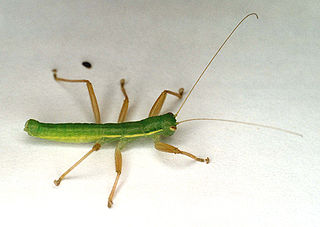
Mantophasmatidae is a family of carnivorous wingless insects within the order Notoptera, which was discovered in Africa in 2001. Originally, the group was regarded as an order in its own right, and named Mantophasmatodea, but, using recent evidence indicating a sister group relationship with Grylloblattidae, Arillo and Engel have combined the two groups into a single order, Notoptera.

Grylloblattidae, the icebugs, or ice crawlers, is a family of extremophile (psychrophile) and wingless insects that live in the cold on top of mountains and the edges of glaciers. They belong, along with Mantophasmatidae, to the order Notoptera. Grylloblattids are tiny, most being less than 3 cm long, wingless insects with a head resembling that of a cockroach, with long antennae and having elongated cerci arising from the tip of their abdomen. They cannot tolerate warmth and many species have small distribution ranges.

Sarcophagidae are a family of flies commonly known as flesh flies. They differ from most flies in that they are ovoviviparous, opportunistically depositing hatched or hatching maggots instead of eggs on carrion, dung, decaying material, or open wounds of mammals, hence their common name. Some flesh fly larvae are internal parasites of other insects such as Orthoptera, and some, in particular the Miltogramminae, are kleptoparasites of solitary Hymenoptera. The adults mostly feed on fluids from animal bodies, nectar, sweet foods, fluids from animal waste and other organic substances. Juveniles need protein to develop and may be laid on carrion, dung or sweet plant foods.

Uis is a settlement located in Erongo Region, Namibia. It belongs to the Dâures electoral constituency. Located in the former Damaraland, it is known for the local mineral wealth. The settlement was established in 1958 as workers' settlement to exploit local tin deposits. It has approximately 3,600 inhabitants and, before being downgraded from "village" to "settlement" in 2010, owned 10 square kilometres (3.9 sq mi) of land.

The Brandberg is Namibia's highest mountain.

The Orussidae or the parasitic wood wasps represent a small family of sawflies ("Symphyta"). Currently, about 85 extant and four fossil species are known. They take a key position in phylogenetic analyses of Hymenoptera, because they form the sister taxon of the megadiverse apocritan wasps, and the common ancestor of Orussidae + Apocrita invented parasitism for the first time in course of the evolution of the Hymenoptera. They are also the only sawflies with carnivorous larvae.
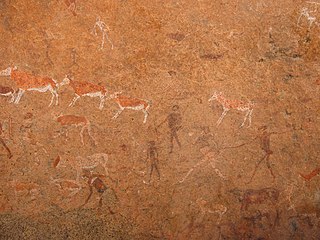
The White Lady is a rock painting, located on a panel, also depicting other art work, on a small rock overhang, deep within Brandberg Mountain. The giant granite monolith located in Damaraland and called 'The Brandberg' is Namibia's highest mountain. The painting's German name is Weiße Dame.

Chyromyidae are small to very small cyclorrhaphous, acalypterate flies (Diptera) currently classified within the Heleomyzoidea by most authors. The majority have a pale yellow integument and bright iridescent green, red or purple eyes. The family is represented in all continents except Antarctica. There are about 150 named species in this family worldwide. There has been no comprehensive taxonomic study to elucidate the generic limits of species in the family. Currently, only four genera are recognised, but ongoing studies of the African species indicate that there are more.

The wingless insect order Notoptera, a group first proposed in 1915, had been largely unused since its original conception until 2006.

Atelestidae is a family of true flies in the superfamily Empidoidea. The four genera were placed in a separate family in 1983; they were formerly either in Platypezidae or considered incertae sedis. While they are doubtless the most basal of the living Empidoidea, the monophyly of the family is not fully proven. The genus Nemedina seems to represent a most ancient lineage among the entire superfamily, while Meghyperus is probably not monophyletic in its present delimitation, and it is liable to be split up eventually, with some species being placed elsewhere. In 2010, the genus Alavesia, previously only known from Cretaceous fossils, was found alive in Namibia, subsequent species were also described from Brazil.
Orthopteroids are insects which historically would have been included in the order Orthoptera and now may be placed in the Polyneoptera. When Carl Linnaeus started applying binomial names to animals in the 10th edition of his Systema Naturae in 1758, there were few animals included in the scheme, and consequently few groups. As more and more new species were discovered and differences recognised, the original groups proposed by Linnaeus were split up.

Johan Wilhelm Heinrich Giess aka Willi Giess is noted for having started an official herbarium at Windhoek, his extensive collection of Namibian plants and generally furthering botanical knowledge of the territory.
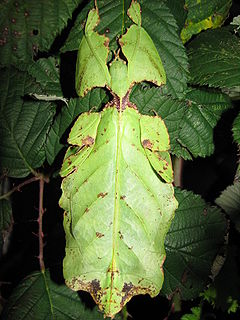
Phyllium giganteum, commonly known as the Giant Malaysian Leaf insect, is a species of leaf-insect described from Malaysia by Hausleithner in 1984 and placed in the genus Phyllium and family Phylliidae. Phyllium giganteum are the largest species belonging to the genus Phyllium reaching 105mm in size. They are found most abundantly in the west Malaysian tropics. The females typically have large elytra that lie edge to edge on the abdomen and tend to lack hind wings making them usually flightless. Males have small elytra and sometimes transparent non-leaflike functional hind wings. Phyllium giganteum found in the wild tend to be mostly females and the first male of this species was not found until 1994. The species has the ability to reproduce through parthenogenesis meaning the females are asexual. The primary reproductive pattern in the wild is unknown however in captivity, the females reproduce primary through parthenogenesis. Eggs tend to be brown or black and glossy and resemble the look of seeds. They hatch around 6 months after breeding. Newly hatched young nymphs tend to be wingless and brown or reddish in color. They develop their green color after feeding on leaves. Both the adult and larval stages are phytophagous meaning they feed on plants. The main plant food sources for this species are oak and bramble tree leaves.
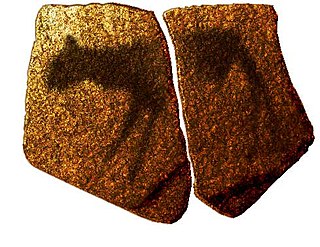
The Apollo 11 Cave is an archeological site in the ǁKaras Region of south-western Namibia, approximately 250 km (160 mi) southwest of Keetmanshoop. The name given to the surrounding area and presumably the cave by the Nama people was “Goachanas”. However, the cave was given its name by German archaeologist Wolfgang Erich Wendt who was working in the cave when he heard of the Apollo 11 crew's successful return to Earth on July 24, 1969.
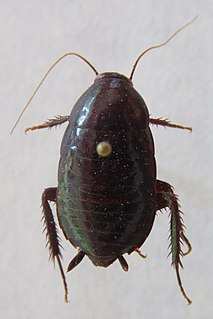
Lamproblattidae is a small family of South and Central American cockroaches in the order Blattodea. It consists of three genera and 10 species:
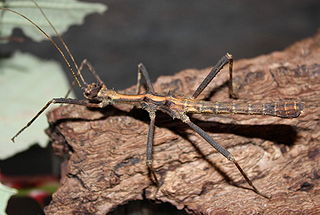
Sungaya is a monotypic genus of stick insects, containing the species Sungaya inexpectata. Its common name is the sunny stick insect, derived from the less commonly used sungay stick insect. The genus name refers to the locality of the holotype, i.e. the region where the insect was first identified. The species name is derived from the Latin as "inexpectatus" and means "unexpected".

New Jersey Amber, sometimes called Raritan amber, is amber found in the Raritan and Magothy Formations of the Central Atlantic (Eastern) coast of the United States. The amber is dated to be of Late Cretaceous, Turonian age, based on pollen analysis of the host formations. The amber has been known since the nineteenth century, with several of the old clay-pit sites now producing many amber specimens for study. A number of organism fossils have been described from inclusions in the amber, including fungi, plants, tardigrades, insects, and feathers. The first identified Cretaceous age ant was described from a fossil found in New Jersey in 1966.
Icius insolidus is a jumping spider species in the genus Icius.
Heliophanus montanus is a jumping spider species in the genus Heliophanus. It was first described by Wanda Wesołowska in 2006 in Namibia.
References
- ↑ Zompro, Oliver; Adis, Joachim (2003). "Mantophasmatodea: Zur Entdeckung einer neuen Insektenordnung mit einer fossilen Art aus dem Baltikum und rezenten Arten aus Afrika". Verhandlungen / Westdeutscher Entomologentag. 2002: 53–62. Retrieved 27 April 2011.
- ↑ Zompro, O.; Adis, J.; Bragg, P.E.; Naskrecki, P.; Meakin, K.; Wittneben, M.; Saxe, V. (2003). "A new genus and species of Mantophasmatidae (Insecta: Mantophasmatodea) from the Brandberg Massif, Namibia, with notes on behaviour". Cimbebasia. 19: 13–24.